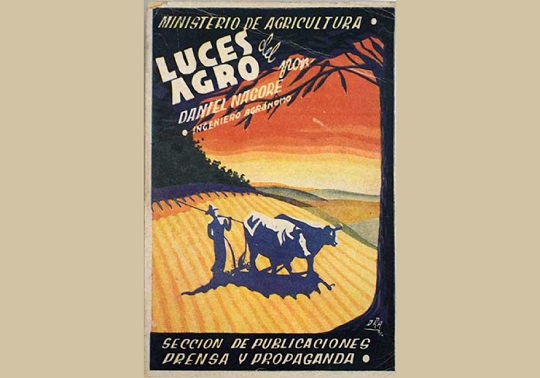
Agrociencia y propaganda (1940-1960): Agricultural dissemination brochures of the first stage of Francoism.
The dissemination activity was one of the fundamental tasks of the agronomic services of the early twentieth century. Street chairs were created, informative publications in the form of brochures and newspaper articles, training courses for specialized technicians, phytopathology museums and demonstration nurseries, booklets and manuals, agronomic magazines, radio programs and documentary films, all with the participation of leading agronomic engineers of the 20s and 30s. This first disclosure was addressed to laboratories and was intended to incorporate new machines and agrochemicals such as fertilizers and pesticides. It was promoted from the provincial agronomic services and the different experimental farms and stations of agronomic research and phytopathology created at the end of the 19th century and throughout the first third of the 20th century. The exhibition includes examples from the Salvat Encyclopaedia of the 20s and 30s. This ambitious editorial project included more than fifty works with a wide range of topics: entomology, rural economy, phytopathology, agricultural machines, cultivation techniques, etc. The military coup and the establishment of the dictatorship of General Franco produced an important change. The agronomic services personnel were subjected to a political purification process and the suspects were expelled or marginalized to supposedly irrelevant positions. All experimentation centers were centralized under the direction of the INIA (National Institute of Agricultural Research) created in Madrid in February 1940. The agrarian disclosure continued to develop within this new framework, now directed more towards the big owners and without any reference to the agrarian reforms of the previous years. The new dissemination brochures encouraged the introduction of new agrochemicals such as arsenic pesticides or DDT with a rhetoric that combined the regime's patriotic and nationalist exaltation with military metaphors to describe the fight against pests and an economic discourse aimed at expand production without any consideration to the living conditions of the farmers. These brochures were also aimed at the dissemination of new products and quality control methods. The exhibition includes a part of the brochures given by the INIA to the López Piñero Interuniversity Institute library.
ScheduleFrom 11 october 2019 to 28 november 2019. Monday, wednesday, thursday and friday at 09:00 to 20:00.
The Palau de Cerveró. First floor.
IILP.
Contact mrile@uv.es









